Mashhad Tourist Attractions
Shandiz County in Mashhad: A Culinary and Nature Lover's Paradise
Shandiz County in Mashhad is a name that evokes the irresistible aroma of delicious kebabs, tender chicken, and mouth-watering shishliks, accompanied by the scent of fragrant Persian rice wafting through the air.
Read moreA Comprehensive Guide to Kooh Sangi Park in Mashhad
Kooh Sangi Park is the second largest park in Mashhad after Mellat Park.
Read moreThe Ghasabe Qanats: The Oldest Qanats in the World
The Ghasabe Qanats, an ancient marvel of engineering, channel life-giving water through intricate underground tunnels, highlighting Iran's ingenious water management heritage.
Read moreMashhad Screaming Forest | Iran's Scariest Natural Wonder
Mashhad's Screaming Forest, known for its eerie sounds echoing through dense trees, intrigues visitors with its haunting atmosphere and mysterious allure.
Read moreKarat Tower: Iranian Lighthouse of the Desert
In the past, it may seem unbelievable how people managed to find their way and reach their destinations without modern navigation tools. However, this was made possible by landmarks and infrastructure like the Karat Tower in Razavi Khorasan.
Read moreThe Tomb of Khajeh Rabie in Mashhad
In the heart of Mashhad, surrounded by a lush, verdant garden, stands the awe-inspiring Tomb of Khajeh Rabie.
Read moreTorghabeh County: A Lush Oasis Near Mashhad
Mashhad has long been a beloved destination for pilgrims, primarily due to the holy shrine of Imam Reza. While the primary purpose of many travelers is to visit this sacred site, there are also other historical and natural attractions in the city to explore.
Read moreFerdowsi's Mausoleum | Honoring the Poet of the Shahnameh
Towering over the plains of Tus in Iran stands a magnificent monument - Ferdowsi’s Mausoleum.
Read moreImam Reza Bazaar in Mashhad | Shop for Authentic Souvenirs
Mashhad is the heart of religious tourism in Iran. The Shrine of Imam Reza in Mashhad attracts millions of pilgrims from around the world to this city, creating a truly multicultural and spiritual atmosphere.
Read moreThe Spiritual Serenity at Imam Reza Holy Complex
The Imam Reza holy complex in Mashhad is one such place, transcending religious boundaries to touch the hearts of all who visit. Dominating the city center, the shrine is a testament to the reverence for Imam Reza, the eighth Shia Imam.
Read moreAncient Village of Nashtifan: Whispers of History
Nashtifan, Iran, is a historical village located in the Tabas desert, offering a unique blend of cultural heritage and natural beauty.
Read moreBest Restaurants in Mashhad | Top 7 Restaurants
Mashhad, the vibrant city nestled in northeastern Iran, has long been revered as a significant religious destination due to its magnificent shrine of Imam Reza.
Read moreBest Hotels in Mashhad
For many Muslims, a trip to Mashhad is a once-in-a-lifetime event.
Read more7 Alternative Places in Iran that Tourists Should Visit
The first-time itinerary of Iran often counts the cities of Esfahan and Persepolis as must-visits, along with Shiraz perhaps. However, there are many overlooked spots which definitely deserve their place at the top of the list. Here is our round-up of the most underrated cities in Iran.
Read moreFire Temple: The Holy Places Where Zoroastrians Worship God
Zoroastrians worship in fire temples or as it's said in Farsi “Atashgah” which are also called “Dare Mehr”, or “Agiyari”.
Read moreMashhad Travel Guide | Top Tourist Attractions
The capital of Khorasan Razavi province in northeast Iran and the second-largest city in the country, Mashhad is best known for its beautiful pilgrimage shrine of Imam Reza.
Read moreMashhad Tourist Attractions
Spiritual experiences come in many forms, from the religious and intellectual to those centered on art and nature. And so often, these moments are brought on by travel—sometimes unexpectedly, and sometimes because we journey in search of sacred sites, through pilgrimages, sabbaticals, and even solo trips, usually when we need an awakening the most. Traveling to these destinations has long been a spiritual practice, whether it's an artificial or natural spiritual site. Not only does visiting them refresh and renew our sense of wonder, but traveling to these sacred places is intrinsically attached to the idea of self-care and a deeper connection to the earth, other people, and the self.
Suppose you want to go on a quest to understand yourself and God and how the better universe works, or you are hoping for a miracle, healing, and transformation. In that case, Mashhad is one of those places you will appreciate and succumb to no matter your faith. It is a place where you will never forget a spiritual connection to the city.
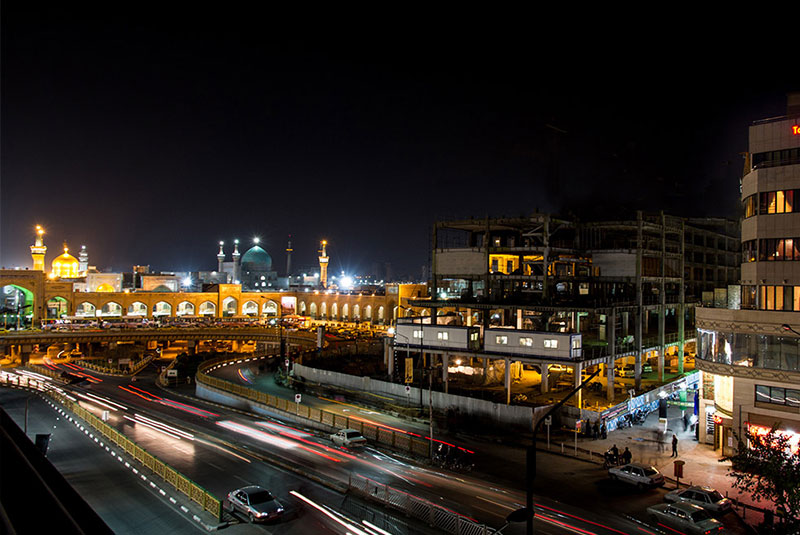
Mashhad, which means 'place of martyrdom,' is Iran's holiest and second-most-populous city after Tehran. It has a population of 3,001,184 people and is located in the Kashaf River valley near the northeast corner of the country, not far away from the borders of Turkmenistan and Afghanistan.
Mashhad is considered the most crucial axis of religious tourism in Iran. It is centered on the vast Holy Shrine of Imam Reza, which has golden domes and minarets that are floodlit at night.
This Shrine commemorates the martyrdom of Shiite Islam's eighth Imam, Imam Ali Reza. Every year millions of pilgrims worldwide flock to this Shrine to pay their respects, giving it a palpably spiritual and multinational feel.
Mashhad is also known colloquially as the city of Ferdowsi, after the Iranian poet who composed the Shahnameh. The city is the hometown of some of the most significant Iranian literary figures and artists, such as the poet Mehdi Akhavan-Sales, and Mohammad-Reza Shajarian a traditional Iranian singer and composer.
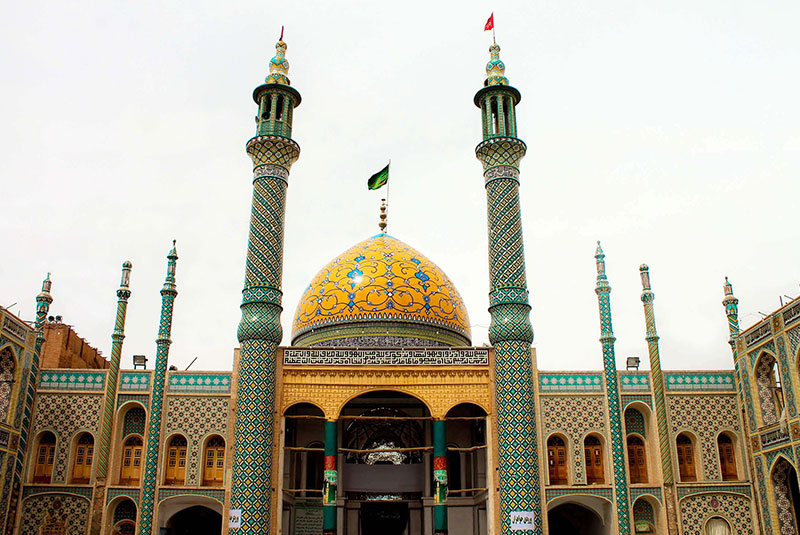
Mashhad is the capital of Khorāsān-e Razavī ostān (province), and due to its location, it is a hub for trade with the countries that border Iran to the east. Due to its place in the valley of the Kashaf Ud River between the two mountain ranges of Binalood and Hezar Masjed. The city benefits from cool winters, pleasant springs, and mild summers.
Mashhad was an educational center with many Islamic schools dating from the Safavid period. Mashhad has been a center for the Islamic arts and sciences and a center of secular and religious learning. Mashhad has one of the largest seminaries of traditional Islamic schools of higher education, and there are an estimated 2300 seminarians in the city. Mashhad is also home to one of the Middle East's oldest libraries, the Central Library of Astan Quds Razavi, with a history of over six centuries. There are over six million historical documents and over 70,000 rare manuscripts from various historical eras in the library.
Top 17 Mashhad Attractions
Apart from the Imam Reza shrine, Mashhad's year-round cool temperatures have much to offer visitors, such as the tomb of poet Ferdowsi and the Koohestan Park-e-Shadi Complex. It also has plenty of culture and food awaiting. Read on to discover the best things to see and do while visiting this popular pilgrimage destination.
1. Imam Ali Reza Holy shrine (a.k.a. Haram-e Imam Reza in Farsi)

Imam Reza Shrine dominated the city center and was developed around the tomb of the eighth Shia Imam. Imam Reza's Holy Shrine is enveloped in a vast series of sacred precincts collectively known as the Haram-e Razavi. The holy Shrine has Intricate blue tile work and Arabic calligraphy is virtually omnipresent across the numerous iwans and minarets.
The Imam Reza's zarih, or tomb encasement, is located underneath a golden dome, with elements dating back to the twelfth century. The tomb is covered by a lattice frame of pure gold, which is very eye-catching and dazzling. There are numerous museums within the shrine complex and seven large courtyards around the Shrine, where millions of Muslims who flock to the Shrine can be seen sitting on the ground and reading the Quran while facing the Shrine. The climax to any Mashhad pilgrimage is touching and kissing the Zarih of Imam Ridha. It is common to stop and bow your head in the direction of the tomb of Imam Reza to greet him upon entering the gate. Whenever locals walk or drive around the city and find themselves facing this direction, they do the same as a sign of respect and purity. Like pilgrims to Mecca who are known as hâji, those who have been to Mashhad are known as Mashti, and Iranians traveling to this city commonly hear the phrase eltemâs duâ, or "keep me in your prayers."
2. Nader Shah Afshar Tomb and Museum
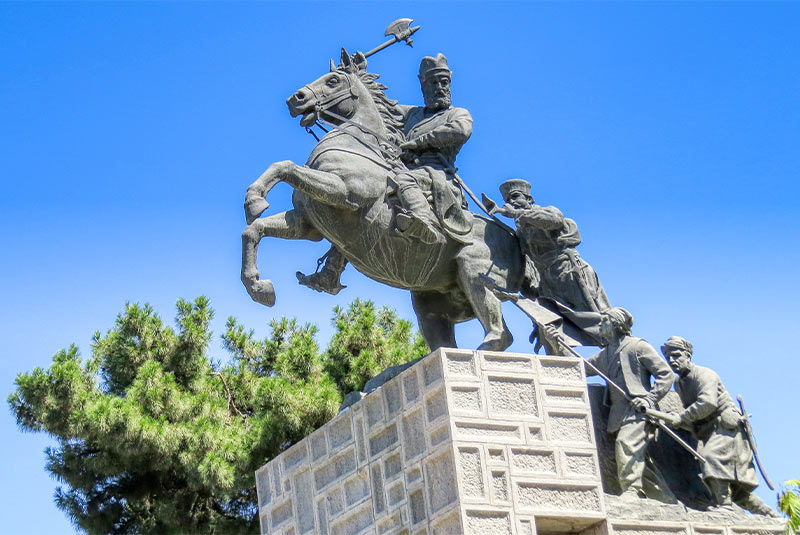
The tomb of Nader Shah was built as a memorial to Nader Shah by Hooshang Seyhoun in 1963. The building of Nader Shah's tomb consists of two parts, a central part which is the burial place of Nader Shah, and a museum hall that displays guns, a rhino-hide shield, and a carpet portrait of Nader Shah on horseback. The monument also has a Portuguese cannon made in the 1590s and seized 30 years later at Hormuz. Nader Shah Afshar, also known as Nader Qoli Beyg or Tahmāsp Qoli Khan, was one of the most influential Iranian rulers in the nation's history, ruling as Shah of Iran (Persia) from 1736 to 1747. Because he was a military genius, as evidenced in numerous martial encounters throughout his campaigns, such as the battles of Herat, samples of implements used in warfare during the period of Nadershah, and a collection of objects relative to millennia before the birth of Christ are displayed here.
3. Astan Quds Razavi Central Museum
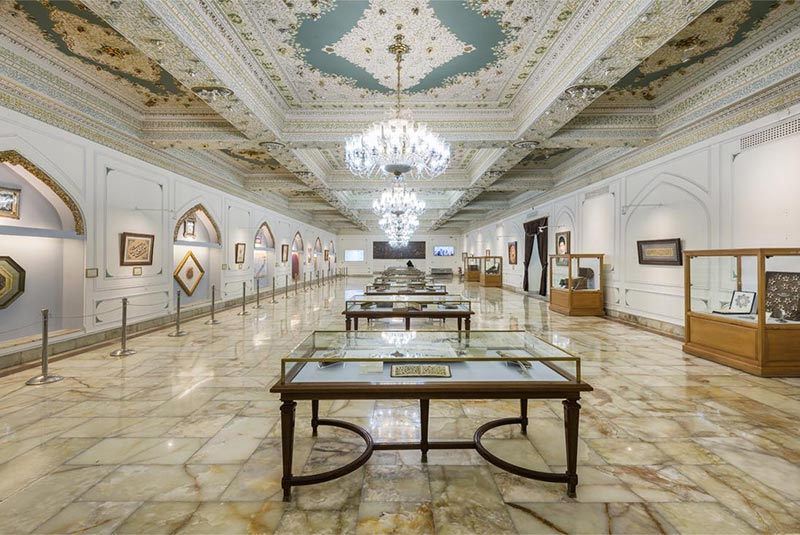
The Asian Quds Razavi Museum was founded in 1937. It is one of Iran's most significant public museums, in the vicinity of the Holy Shrine of Imam Reza (AS) and Goharshad Mosque. Astan Due to the variety of treasures, the Quds Razavi Central Museum has been visited for almost eight decades by millions of pilgrims and tourists from Iran and other countries worldwide. The purpose of creating this cultural place was to show rare and valuable treasures given to Imam Reza, which have been preserved intact in the treasury of the Shrine through the centuries. Moreover, the museum contains a noticeable accumulation of articles once in use in the Shrine and handicrafts, works of art, and antiquities donated by the devotees of Imam Reza (AS). Different coins, stamps, dishes, medals, and aquatic creatures are shown in this museum.
4. Koohsangi Recreation Place
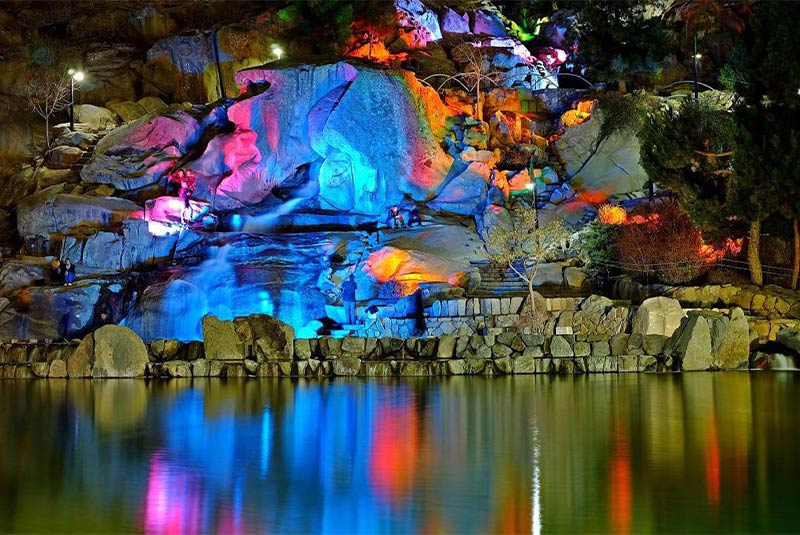
Koohsangi recreational place is the oldest recreation park in Mashhad City. This park has two stone mountains called "Kooh- Sangi." Kooh Sangi Park has a fantastic night view as one can see most parts of the city from the heights of the mountain. It has a summer house with a large pool that runs 100 meters in length and 60 meters in width.
Underground waters from the Gonabad area feed the reservoir. Alongside are paved paths and trees, which enhance the beauty of this area, also famed as "Dalan-e-Behesht" (The corridor to Paradise). Koohsangi also has a playground for the children to play and carriage riding is available. There is also a water flow from the top of the mountain streaming down to the grounds making a lovely natural view.
5. Goharshad Mosque
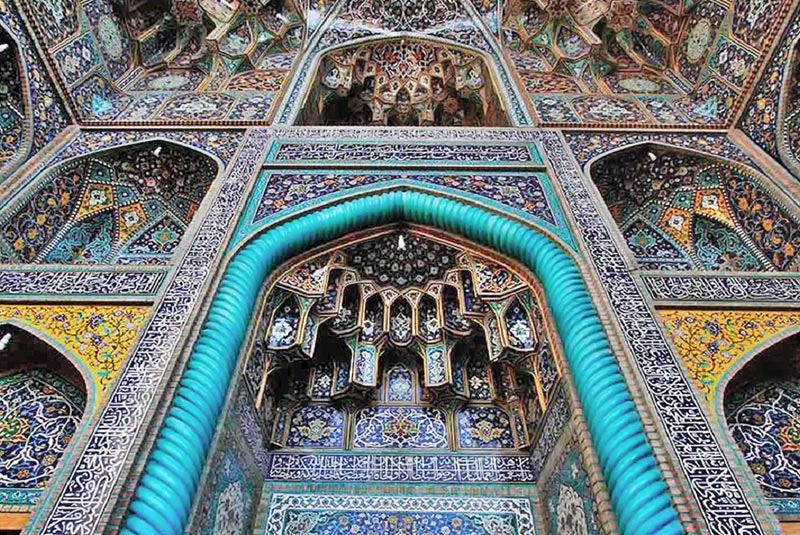
Goharshad Mosque is one of the most famous mosques in Iran, left behind by the Timurid Kings (1370–1507). Qoharshad is the oldest mosque in Mashhad. Its unique architecture and mesmerizing beauty have made it one of the leading cultural, historical, and religious attractions. Apart from the spiritual aspects that draw many people to the mosque, Goharshad The mosque is a massive example of the finest arts in architecture, tile work, and calligraphy. This mosque is tied to many historical disasters adding to its credibility among people.
The mosque consists of a sizable azure dome, two minarets, four verandas, a courtyard with seven big bed-chambers, and a large altar made of a stony dado and mosaic faience shell of the finest quality. The shiny mirrors on its ceiling are unique. The entire surface of the minarets, walls, and the surrounding arcades are decorated with fine mosaic and glazed tiles produced in various colors, including ultramarine, turquoise, white, transparent green, yellow, and light yellow, and ebony.
There is an old inscription carved by the famed Iranian calligrapher Baysunqur Mirza on the margins of the main veranda's entrance. There is a museum carrying various handicrafts, including a collection of carpets and gold-woven works donated to the holy Shrine of Imam Reza. Moreover, the mosque has a public library holding many books.
6. Reza Bazaar in Mashhad
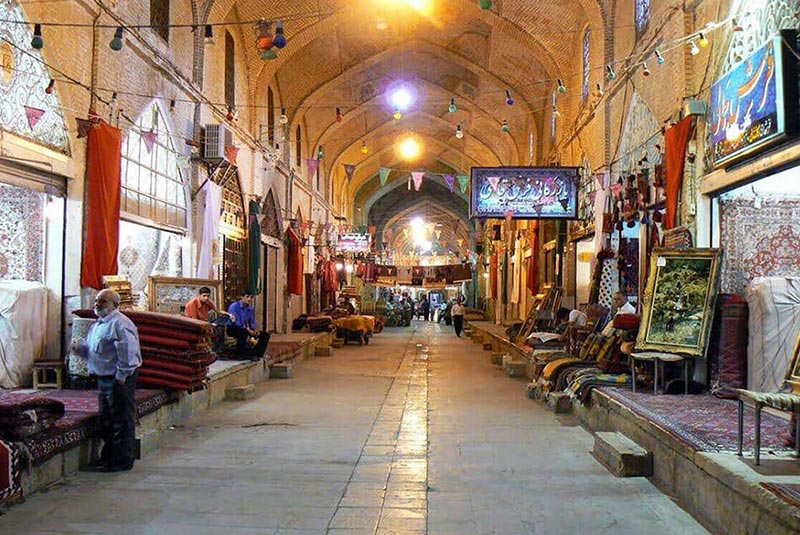
Reza Bazaar is an old bazaar in Mashhad City, located on the eastern side of the Imam Ali Reza Holy Shrine. Mashhad Bazaar Reza is a trendy shopping mall among pilgrims and tourists who mainly travel to visit Mashhad attractions. Reza Bazaar is a roofed market supplying souvenirs like saffron, turquoise, opal rings, perfumes, and clothes. This bazaar has two-story buildings and over 1700 trade units.
The Bazaar Reza reaches more than one kilometer in length, and walking through this long market by seeing shops and goods will spice up your visit. The bazaar is designed to look traditional but is a 20th-century creation.
The bazaar has a main entrance from Shahrivar Square and contains 12 sub-entrances. Upon entry, you are faced with a wide range of goods such as prayer rugs, Turbah, Rosary, and Mashhad perfume on the first floor. In addition, all kinds of clothing, decorative items, turquoise rings, saffron, barberry, dried fruit, and spices can be seen on the first floor of Imam Reza Market of Mashhad. Another exciting feature of Bazaar Reza is the different functions of the second floor, where you may see many manufacturing workshops for ornamental stone carving, goldsmithing, and embroidery.
The combination of various oriental spices, especially saffron, and the scent of perfumes such as the Mohammadi flower, along with the eye-catching images of colorful rosaries and multiple ornaments, have made Bazaar Reza an attractive and spectacular place. Moreover, religious products such as seals and prayer rugs have created a special religious feeling in the bazaar, which makes the experience quite different from other purchasing experiences. So, do not hesitate to pack your suitcases and plan your Mashhad travel to enjoy them.
7. Daroogheh Historical House
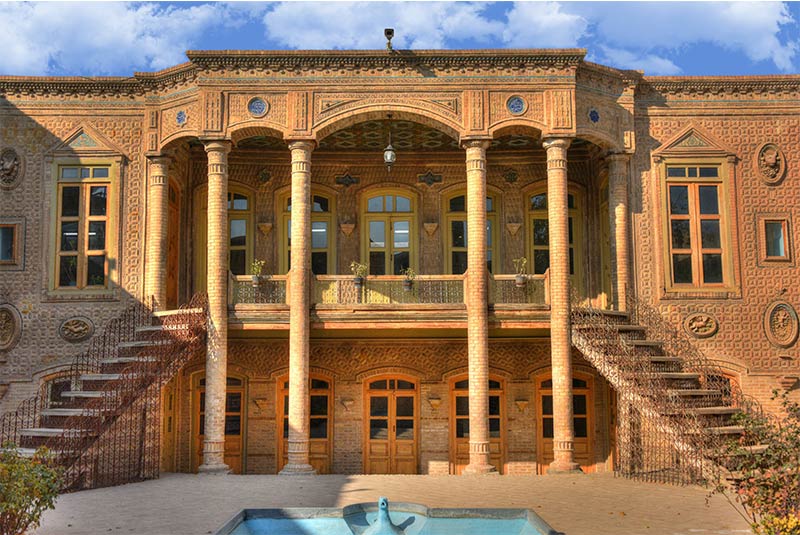
Daroogheh historic house is one of the last traditional houses in Mashhad. This house was built for the Sheriff of Mashhad Yousof Khan Harati of the northeastern city. The design of this house is influenced by Russian architecture. Therefore, it differs from other homes of the Qajar era. It was not only one of the most luxurious houses of its time but also the only house in Mashhad with a private bathroom and bakery. Since there was no air conditioner or heating system then, the house also had a fantastic basement with a water pool to save water and keep the house cool in the summertime.
In this semi-Iranian traditional house, the influence of Russian art is seen in the shape of bricks, where seven-colored tiles are used. You can also see wood carvings under the roofs and detailed stuccos in the yard. The house still has some Iranian taste, which can be seen on the balcony with a staircase on two sides and the walls of the yards made of different-shaped bricks, with stucco statues like a human head, lion head, and angles with wings.
Darougheh Historical House has a three-sided structure and its entrance on the south side opens into a yard with a pool and small green spaces.
Top Attractions near Mashhad
8. Tomb of Ferdowsi in Tous
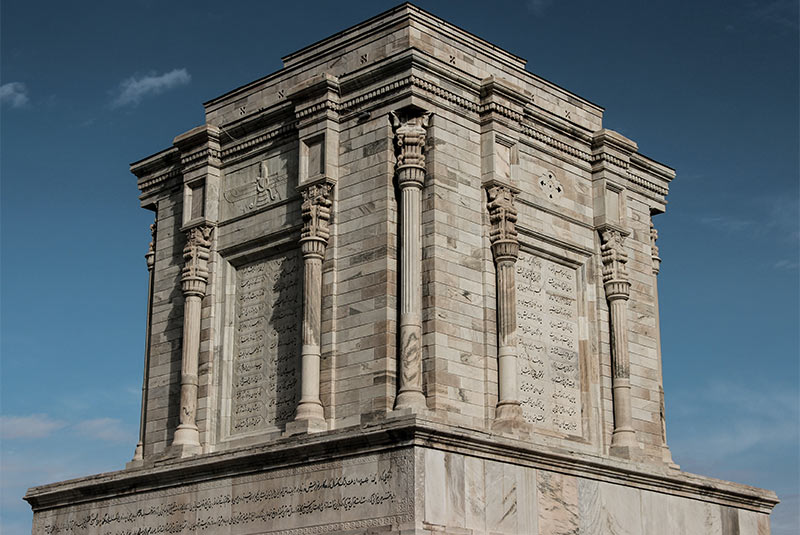
The Iranians consider the Ferdowsi tomb to be Iran's most honorable cultural attraction. It is located in Mashhad in Toos Garden. The tomb was designed by the prominent Iranian architect and designer Houshang Seyhoun out of white marble in the early 1930s under Reza Shah's regime. Persian language and depictions of various creatures and battle scenes from his book are engraved on the walls of Ferdowsi's tomb.
Abolqasem Ferdowsi of Toos is Iran's most prominent epic poet and is highly regarded globally. The literary masterpiece of Ferdowsi is called Shahnameh, or the Book of Kings. It is the longest epic poem in the world. Ferdowsi spent thirty years of his life writing this masterpiece. It is firmly believed that it was because of this work that the Farsi language was saved from demise and oblivion, and that is why the Iranians have named Ferdowsi the savior of the Farsi language.
9. Chaldareh Tourist Complex
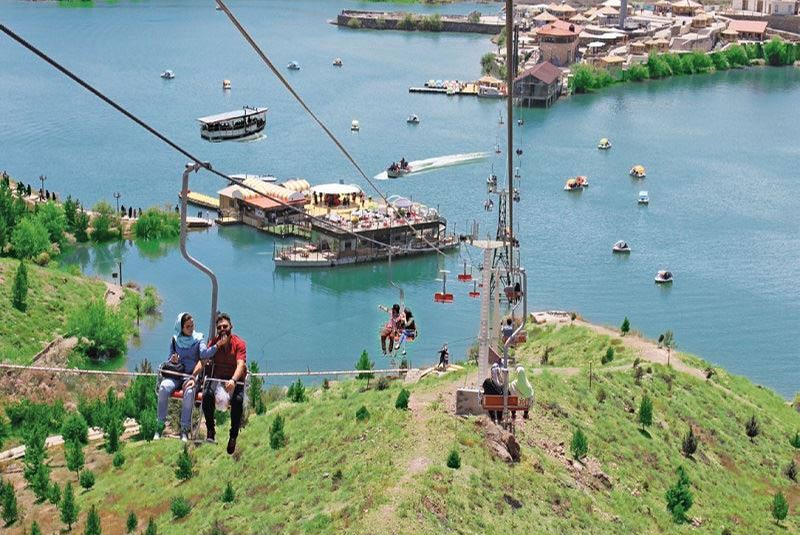
The best place to visit in the winter season is the Chaldareh tourist complex. Chaldareh tourist complex is located about 10 kilometers from Mashhad and on Mashhad-Torghabeh road. Chaldareh in Persian, "Validare," is one of the entertainment places in Mashhad. It was initially a dam constructed over a river called Jaghargh in 1997 in the Torghabeh region of Mashhad that supplies water for agriculture and people's daily use. However, a touristic area was established behind the dam containing recreational facilities such as boating, fishing, and restaurants. Nowadays Chaldareh tourist complex is well known as a tourist area rather than a dam. It's a pleasant and beautiful environment with lovely views that will enable you to get nice photos in every corner of the complex. The presence of the Jaghargh River makes the weather so clean and favorable. You would enjoy the lovely scenic view and many facilities such as sailing, boating, Jet Ski, bungee jumping, and mountain train wagons. The cable car of Chaldareh, running over the ground and a part of the lake, will double the joy of your trip.
10.Torghabeh and Shandiz County
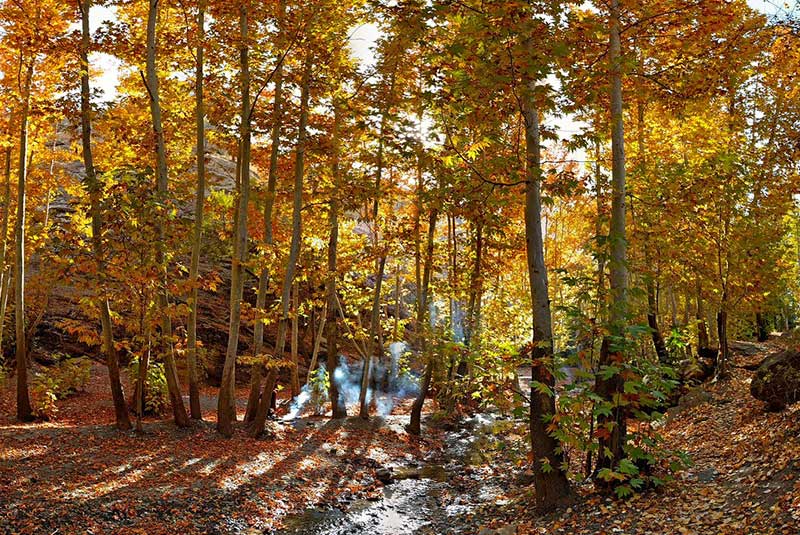
Torghabeh and Shandiz County (formerly Binalud County) is a county in Khorasan Province in Iran. The capital of the county is Torghabeh, and the county is subdivided into two districts (bakhsh): Torghabeh District and Shandiz District.
Torghabeh and Shandiz are considered the natural paradises of Mashhad. Since they are located in the ever-green and water-rich mountains of Binaaloud, they are deemed attractive spots for tourists and visitors. Shandiz is a Paradise of all sorts of fruits, especially cherry. The hospitality complex of Bagh'salar, the beautiful Aabshaar or waterfall street, Abrdeh ski-run, Variani bike-riding ground, Zoshk village with its richly filled gardens and beautiful nature, the jungle park of Shandiz, and the astronomical planetarium of Razavi is some of the most popular and well-known attractions of Shandiz. The best souvenir found in Shandiz is sheepskin or fur clothing. Torghabeh is another paradise adjacent to Shandiz. While visiting Torghabeh, remember that basket-weaving, carpet, and rug-weaving products are among this region's most essential handicraft industry products. You can purchase them and take them home as a valuable remembrance.
11. Kalat-e-Naderi
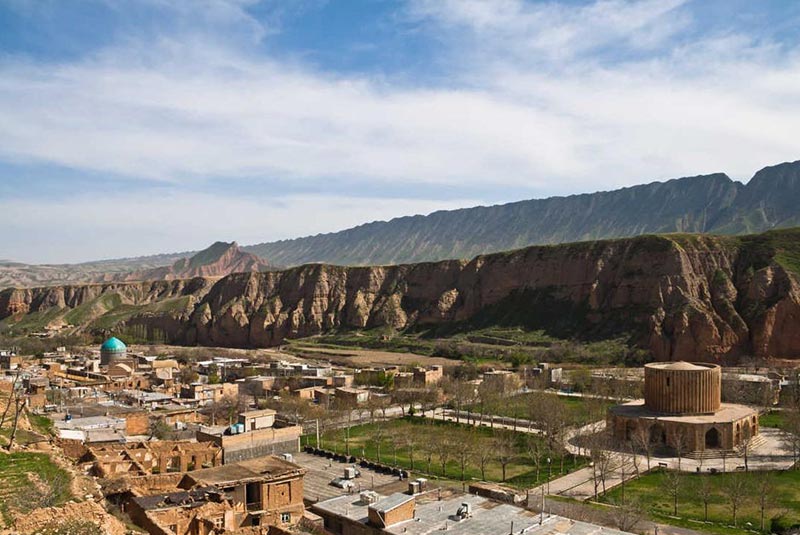
Kalat-e Naderi is a massive natural fortress about four miles in circumference since before the Achaemenid era. It is surrounded on three sides by high cliff walls on the south, west, and eastern sides. It is located about 44 miles north of Sousa, in Kalat County, Razavi Khorasan Province, Iran. The complex of Kalat Naderi was created in the year 1160 AH. It is the only fortress ever to withstand a siege by Tamerlane. Thanks to its walls within 35 km in length and 10 km in width. Existing inscriptions are evident, including one written in the Turkish language and the Nasta'liq script.
Kalat Naderi is a lovely, climactic city full of sightseeing and natural attractions. This beautiful city was once home to valuable jewelry and spoilers, and today it holds both natural and historical treasures. Khorshid Palace is one of the most elegant palaces in this city in Iran. This palace is in the center of an enormous garden and has three floors. It is a tomb, not a living place or a king's palace built to be Nader Shah's Shrine.
Khorshid Palace of Kalat (Sun Palace)
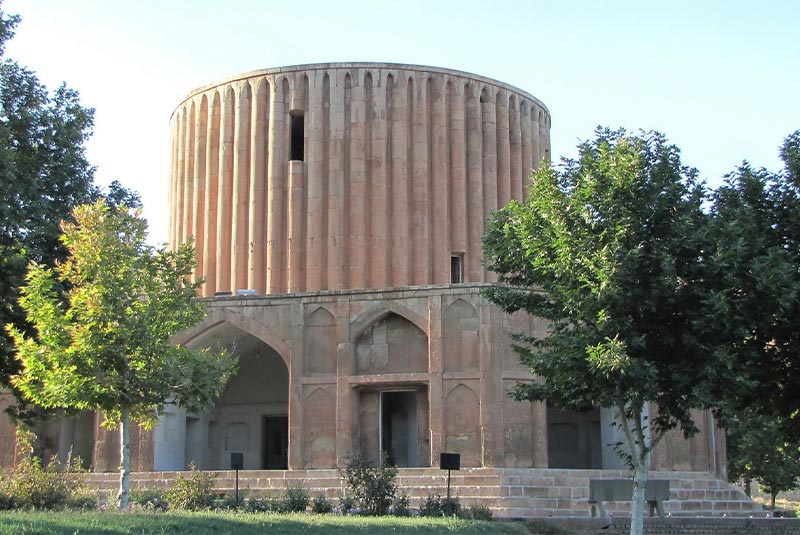
The Sun Palace of Kalat is a palace built in the year 1740, and it is one of the few buildings constructed during the reign of Nader Shah Afshar. Khorshid Palace is a magnificent historical monument and the most important tourist attraction of Kalat City in Khorasan Razavi province. In this palace's center is a tower enhanced with architectural fire designs. The facade of this palace is cylindrical, built of black marble. The castle stands 20 meters high and contains 12 rooms decorated with paintings and ornamental works such as plaster moldings. The external facade is decorated with stones and images of vases, flowers, leaves, and fruits.
12. Tomb of Arsalan Jazeb
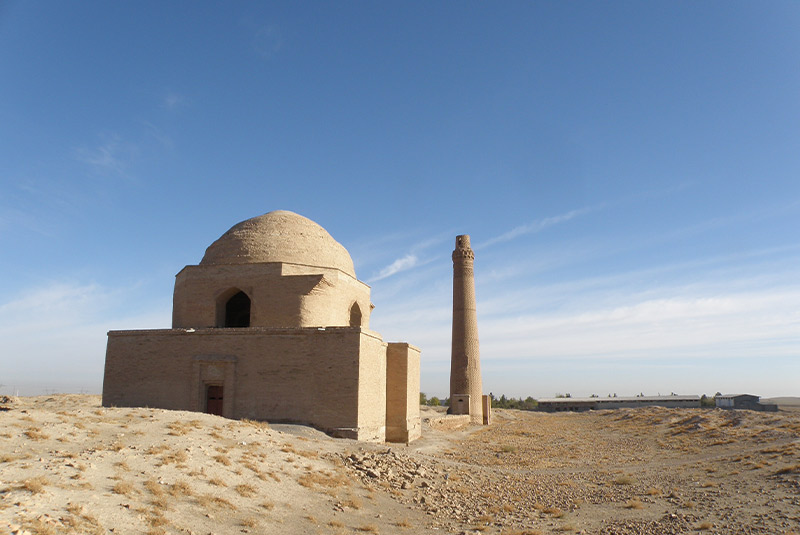
Arsalan Jazeb (Arsalan Jazib) was the governor of Tous, a contemporary of Sultan Mohammad Qaznavi was the first one to erect a monument over Ferdowsi's grave. The tomb of Arsalan Jazeb has located 37 km from Mashhad. It is an octagonal building with a dome and a minaret from the Ghaznavid dynasty. The tall minaret of the tomb is situated a few meters from the crown. The walls of the tomb are adorned with inlays. Inside, the building is decorated with bright-colored bricks, and on the fringes of these walls, there is an inscription in the 'Kufic' script on a blue background.
13. Kashafrud Valley
Kashafrud Valley has historical significance because Alexander the Great passed through the valley of the Kashaf River. The Kashaf Ud valley is 240 km. in length and originates from the mountain ranges of Hezar Masjed and Binalood. About 900 villages surround this valley, and public spots are plentiful in this valley.
14. Qadamgah Mausoleum
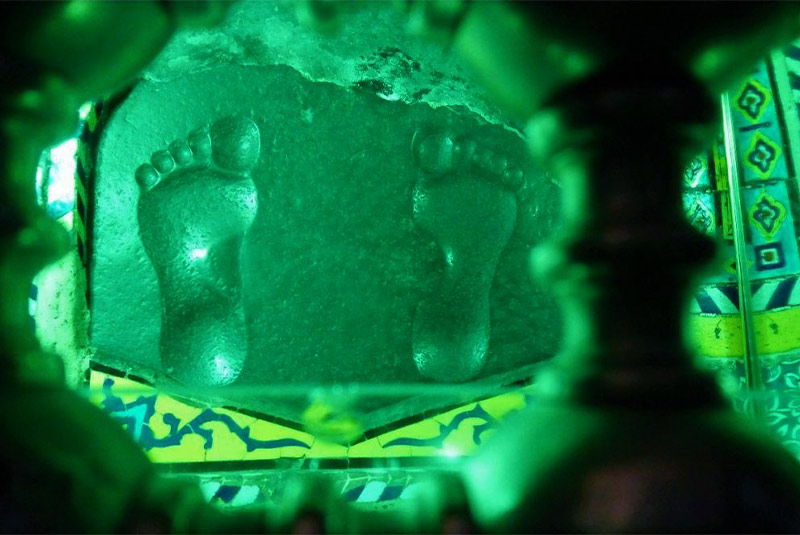
This beautiful Mausoleum dates back to the 11th century. It is octagonal shaped with tall Shah erected porticos and two-storeyed arches located in the village of Qadamgah and Soleiman in 1091 AH. it is decorated with seven colored tiles, and plaster moldings dome of this structure has been decorated with white and turquoise-colored diamond-shaped figures which surround the dom. In this Mausoleum, there is also a stone with two feet' foot marks visible. It is said that these impressions belong to the feet of His Holiness Imam Reza (AS). Al Abd Mohammad Hossein also wrote an inscription on the walls in the Thuluth script. There is a water spring near the Qadamgah, according to the religious narratives, which was boiled from the ground by the will of Imam Reza.
15. Khajeh Rabi's Tomb
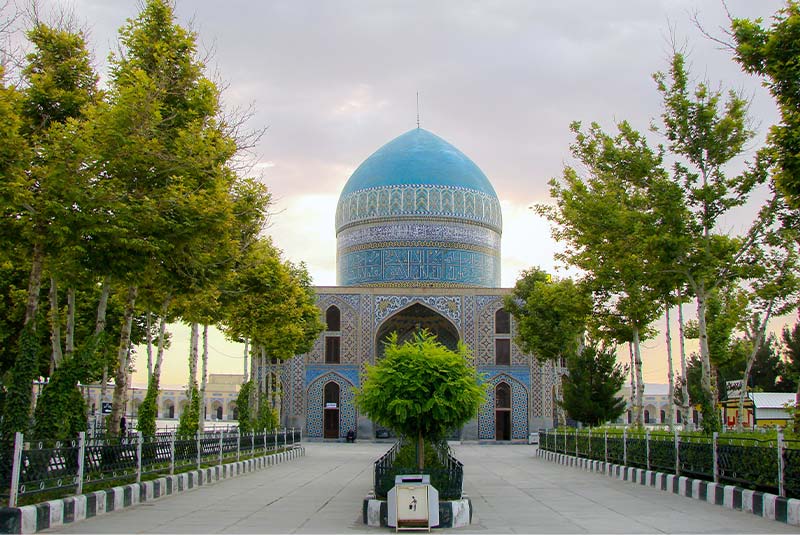
The Tomb of Khajeh Rabie relates to the Safavid era and is located in Mashhad's enormous, beautiful garden. Khajeh Rabi's Mausoleum is reputed to be the tomb of an early Islamic era figure. This Mausoleum is octagonal in shape and houses many rooms, large halls, and porticos styled in intricate and unique oriental architecture. It also has an onion-shaped turquoise dome covered in turquoise tiles. The interior of the monument has gold and ocher-colored decorations. The inscriptions in these Mausoleums are in Thuluth and Bana'i scripts. This famous and renowned tomb is situated 4 km. North of Mashhad on the Khajeh Rabi Road. The facade of this monument has many eye-catching and exciting architectural and decorative features. The colored tiles on the outside facade, golden paintings on the inside wall coverings, and two cornices of Ali-Reza Abbasi's script gave a special appearance to this building.
16. Akhenjan Tower
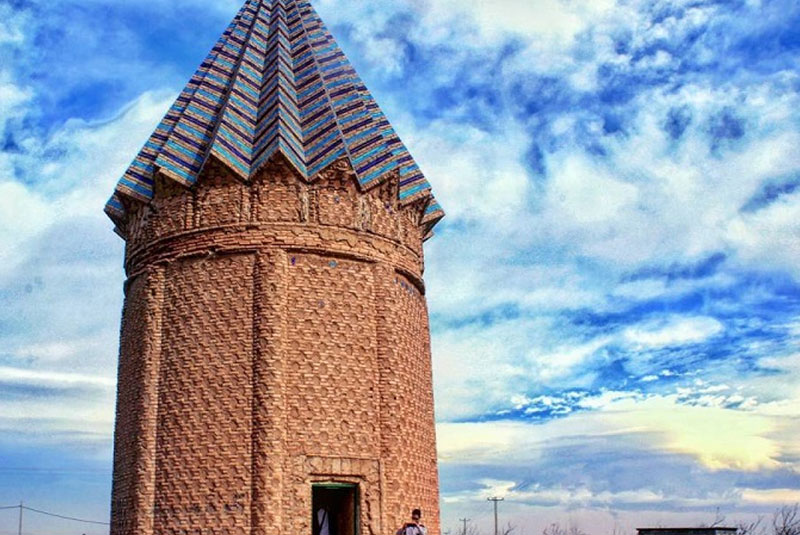
The tower of Arkhangan is a tower that dates back to the Teimoorian era. It is located on the southern slope of Tabarak Mountain in the Bibi Shahrbanoo Mountains, north of Aminabad Road. The building is octagonal, and its brickwork is fancy and adds to its beauty. The construction is made of ballast and plaster and is well standing. From the top of the building, the beautiful view of the Varamin plain can be seen in the south, and you can see the Bahram Rey fire temple in the middle of the plain. The use of the structure is unknown, but it could be the possible Mausoleum of one of the Seljuk kings.

